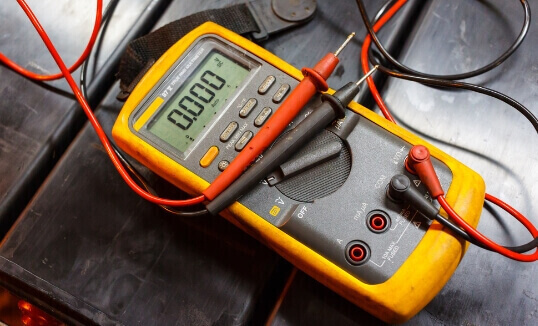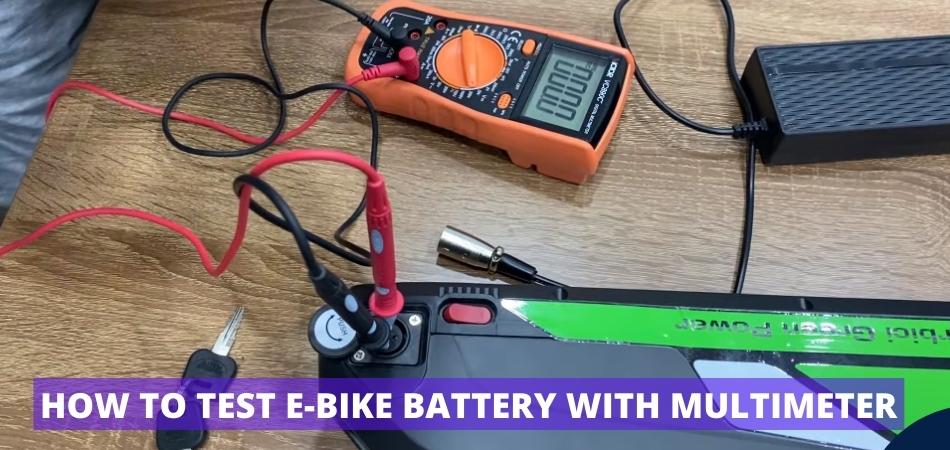Testing the battery of your electric bike is an essential operation to ensure that your battery is in good condition. It also allows you to have a better idea of its real autonomy, which may be less than the manufacturer’s. So, this post on how to test e-bike battery with multimeter will take you through all you need to know about testing an ebike battery.
You can test e-bike batteries using a quality multimeter to measure the current, voltage, and resistance. You have to connect the multimeter to the battery of the e-bike, and then you have to choose What you intend to do.
To test the e-bike battery with a multimeter, switch off the bike, remove the battery, turn on the multimeter, and set it to DC. Next, press on, choose the positive lead, insert it into the positive port of the battery connector, put down a clamp onto the negative lead, and then place it into the negative port of the battery connector. Then you can go ahead to read and note the measurements.
Contents
What is a Multimeter?
A multimeter is a tool that can measure voltage, current, and resistance. If you are just starting in electronics, you will want to understand how to use this tool.

Learning to use a multimeter can help you troubleshoot problems with your circuits, figure out which components are broken, and understand your components’ values. A multimeter may seem intimidating at first, but it is pretty easy to use.
It is used for electrical testing and troubleshooting in various applications, from electronic devices to residential wiring. Multimeters come in two forms: analog, with a needle dial to read voltage, and digital with an LCD screen.
The meter will also have leads attached via probes on each end of the unit for reading input signal levels at different points, along with an electrical circuit board.
In addition, multimeters are good for measuring voltage because they can read DC (direct current) and AC (alternating current).
They are also easy to use as you just have to connect one lead from your multimeter to a wire or terminal on the circuit board, then attach the other lead to another point to see how much voltage is being generated between these two points in real-time while you are working with them.
Furthermore, there are different types of multimeters, and they have their unique purpose. The types you should know are listed below.
Types of Multimeters
There are many different types of multimeters, and each one has its unique purpose.
Analog multimeters:
Analog multimeters are the simplest type of multimeter. They can be used to measure voltage and current in a component and its electrical resistance by placing a current through it and measuring the voltage drop across it.
However, this type of multimeter is no longer as common as it used to be as they do not offer users nearly as much accuracy or precision when compared to their digital counterparts.
Digital Multimeters:
A digital multimeter is ideal for measuring voltage, current, and resistance in electronic circuits. These devices usually include an LCD display that shows the measured values in numerical form.
As a result, Digital multimeters are more accurate than analog ones, although they tend to cost more due to the inclusion of the LCD and other advanced features such as storing data for future use.
Clamp Multimeters:
A clamp meter is another type of digital multimeter which uses a pair of hall effect sensors or magneto resistive sensors (MR sensors) instead of probes for making contact with the circuit under test.
What Parameters Are You Testing In An E-bike Battery?
You can test different parameters in your e-bike battery using a multimeter. You must regularly test it as it will let you know the condition of your bike battery before you take it out to ride. So, below are some of the parameters you can test.
Temperature
Battery temperature is one of the biggest factors affecting the performance of your ebike battery. Therefore, testing the ambient temperature of the battery using a multimeter will let you know the condition of the battery and what you should do.
Testing the temperature is important to protect your 1000-watt, 750 watts, and 500 Watt E-Bike battery, keep it working safely and help extend its life.
Voltage
Another parameter you have to test is the battery’s voltage, and you need to ensure that it matches the voltage of the e-bike. A mismatch in these voltages could cause damage to the e-bike and potentially injure the rider.
Current
Current is the flow of electricity discovered in a circuit and is measured in Amps. The current rating of a battery is important to understand because when buying an e-bike battery, you want one that has enough power to run your bike. If the current of the battery is low, it might not be able to run the ebike.
So, you can test the current of the battery to know if it has the right rating to power your electric bike.
Charge/discharge rate
Another parameter you can test is the charging time of the battery. This parameter must be tested to ensure the battery is fully charged before using the e-bike. Also, it helps you know the battery’s health condition as you get to know its discharge rate.
Cycle life
The battery’s cycle life is an important aspect when choosing the battery. This is because the level of discharge affects the life span in a significant way. When it is full, it does not use much power, but it needs more power to operate when it is half-full, which shortens its cycle life.
So, testing this parameter will let you know the number of times a battery can be discharged, then recharged.
Capacity
Another parameter you will test is that all cells have equal capacity and no variation between them. This ensures a more uniform performance from each cell, which prevents weak spots from occurring in the battery.
Depending on your bike, there might be more that you need to check, but this is the list of the common parameters that you need to check with your bike battery.
How To Test E-Bike Battery With Multimeter?
If you have got an e-bike, then you will want to test its battery with a multimeter. Below is the right way you can go about testing your electric bike.

Turn Off the Bike
The first step you need to take with testing your ebike is disconnecting the charger from the wall socket and removing it from the bike. Also, turn off all power on the bike. You should ensure the battery is fully charged, as it will help you know the status of the battery when testing.
Connect the Multimeter
You need to connect the multimeter to your battery. Set your multimeter to read DC voltage and set it to at least 20 VDC or higher, depending on your DC voltage reading. Connect your multimeter’s positive (red) or negative (black) lead to one end of the battery pack and the negative or positive lead of your multimeter to the other end of the battery pack.
Test Load Battery
You need to set the multimeter to Direct current. AC is not the best option as it can overload the ebike battery. This test does not just test the ability of the battery to turn on but also ensures that communication with the motor is in good condition.
Test the Voltage
You can do that with the step below. Turn on your multimeter and set it to 20 V DC. Make sure that all probes are disconnected from the meter and that it is not in continuity mode.

Touch each probe to its respective terminal on the tester lead: black probe to the negative terminal and red probe to the positive terminal.
Read the voltage reading, which should be around 22 volts for a fully charged battery with an average of 11 cells. Do not forget to turn off your multimeter before removing it from the battery.
Test the Current
Connect one probe to the red port of your battery and one probe to the black port of your battery. Make sure that both probes are touching metal and not any other material, including plastic or rubber, which will cause a false reading.
Write down the current that is being read by your multimeter. The typical voltage for an e-bike battery ranges from 48 to 72 volts.
Test the Resistance
Test the resistance of your e-bike battery by fully charging it, then letting it discharge for a few hours. Then, take your multimeter and test the resistance. If your multimeter has an ohms setting, use that. If not, use the lowest setting on your multimeter.
Using the probes that come with your multimeter (not the ones for electrical currents), check all the terminals of your battery for resistance. If you encounter resistance at all of your terminals, this indicates a good battery.
Alternative Ways To Check E-Bike Battery
The alternative way to check your ebike battery is through the use of a load tester. You can use a load tester to check your e-bike battery if you have the right equipment.
A load tester is a device that attaches to the battery terminals and then puts an electrical load on the battery. This reveals how much of a charge remains in the battery.
If you don’t have access to a load tester or you’re unsure about how to use one, your local bike shop will likely be able to help you out with this. You may need to leave your bike with them for a few hours while they perform the test.
However, if you want to do the task yourself, the method below will be of great assistance.
Steps to check your ebike battery using a load tester:
- Turn the bike on and let it run for about 30 seconds.
- Turn off the bike and disconnect the load tester from where the charger normally goes into the battery pack (you will probably need to take off some casing around the battery connector).
- Connect the load tester to the battery (you may need to charge the load tester first).
- Turn on the load tester; it should give you a measurement of how much charge is left in your battery.
Conclusion
If you have an electric bike, you need to know how to test its battery. Otherwise, you might find yourself out on a ride that gets cut short or, worse, stranded.
Your ebike battery is what makes your bike get on the move. When you’re riding around, it stores all of the energy you’re creating and then uses it to power your motor. If something goes wrong with this battery, your bike won’t work anymore.
So, if you need the right information on How To Test E-Bike Battery with Multimeter, then I suggest you read through this page. We have the right information you need to learn the simple methods to check and test your battery status.

